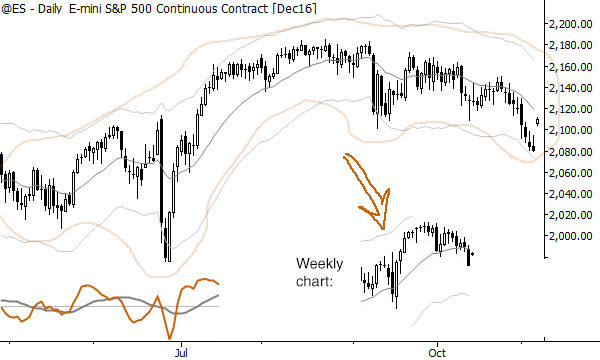Matt asks:
Hi Adam, I have a question regarding trading timeframes. Do you have multiple trading timeframes or do you tend to trade one? For example, scanning the daily charts for set-ups and scanning the weekly charts for set-ups
Good question, and I think there are a few answers, depending on what kind of trader you are and where you are in your development.

Personally, I always have daily/weekly/monthly charts on my screen, but I often only look at the daily. It’s very easy to infer weekly structures from the daily chart, which is what I’ve shown in my (mostly ineffective) illustration on this page: If you can mentally reduce the daily chart to a swing outline, then you will have the same price structures you would see on the weekly. I used to work intensively with multiple timeframes, and have written on the subject here, among other places. Over the years, I’m simplified more and more, so I really focus my attention on the daily chart.
One thing I see traders struggling with a lot is the idea of using a lower timeframe to better time entries on the trading timeframe. I think the problem is that you’re often trying to find that elusive (i.e., nonexistent) free lunch–entering a trade on NFLX (a ~$125 stock at the time I’m writing this) with a $0.25 stop based on some 15 minute price structure. Tight stops have never worked well for me, and I’ve never seen them work well for anyone in practice. (They do, however, work well for people selling trading systems and chat rooms–tight stops are the marketer’s secret weapon.) These stops don’t reflect the volatility of the market, and you will have very low win ratios using them. Will your reward/risk ratio compensate for a low win ratio? Maybe or maybe not, and that’s something you need to address in your system design and testing.
You might ask why my setup still includes weekly and monthly charts, and I think there are a few answers. While the minimalism of a single chart appeals greatly, there are some things a daily chart alone cannot do for you. What are some of these things?
- Specific indicator or quantitative measures from other timeframes. If I’m looking at a momentum or extension indicator on the higher timeframe, I can probably back into that from the trading timeframe, but why? It’s usually easier to use that higher timeframe explicit. However, make sure that you are doing something that works. The very common scheme of using a higher timeframe 3 moving average trend indicator actually puts you on the wrong side of the market! Proper system testing will avoid pitfalls such as this.
- History! History matters. My daily chart goes back about 6 months on most of my screens. My weekly goes back two and a half years, and my monthly goes back over 10 years. There’s no way to get that kind of long perspective on where a market has come from and how it has done so other than looking at the long history. For my eye, this is perhaps the greatest value in a higher timeframe chart.
You’ll find what is right for you, but just be careful of adding layers of complexity unless they are justified by your results. Make sure you’re getting paid for your work–that’s a good concept to keep in mind as you balance between simplicity and complexity in your own trading system design and development.